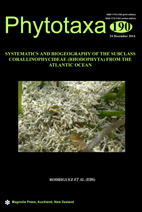Abstract
The calcareous crusted epiphytic algae are a group of extremely delicate, fragile and poorly studied algae. The subfamily Melobesioideae (Corallinophycidae, Rhodophyta) includes the genus Melobesia, which has no record of molecular analysis.However, thanks to measurement data, it was possible to find enough similarity for taxonomic identification of two species: Melobesia rosanoffii (Foslie) Lemoine, described for the first time in South Atlantic Ocean, and Melobesia membranacea (Esper) Lamouroux, first described in southern Brazil. The group has undergone several changes of classification from animals to plants. Today crusty coralline algae have great importance due to the possibility of easy spore dispersal between oceans.

